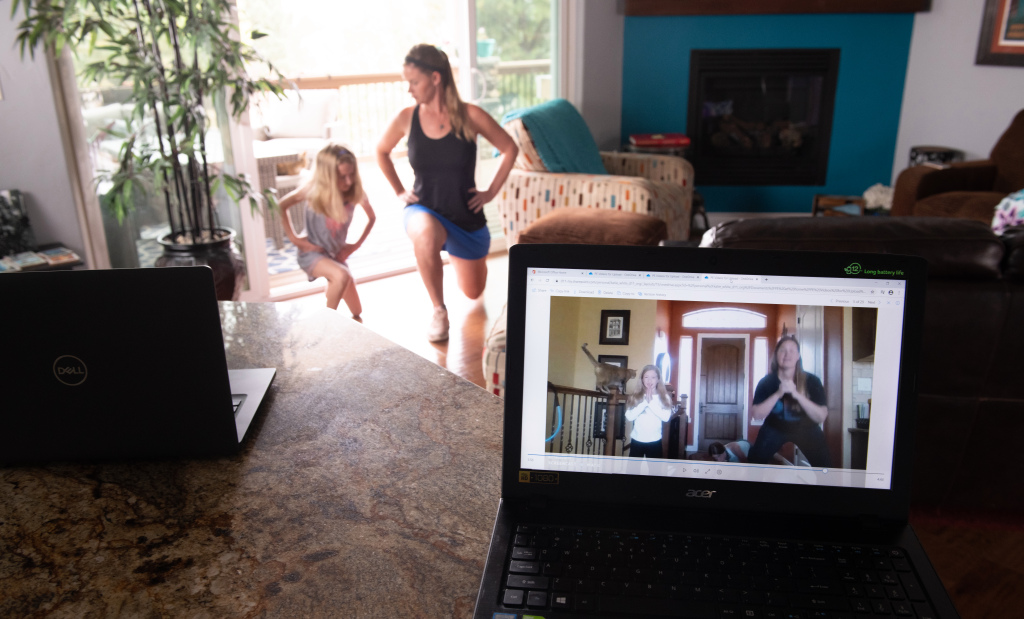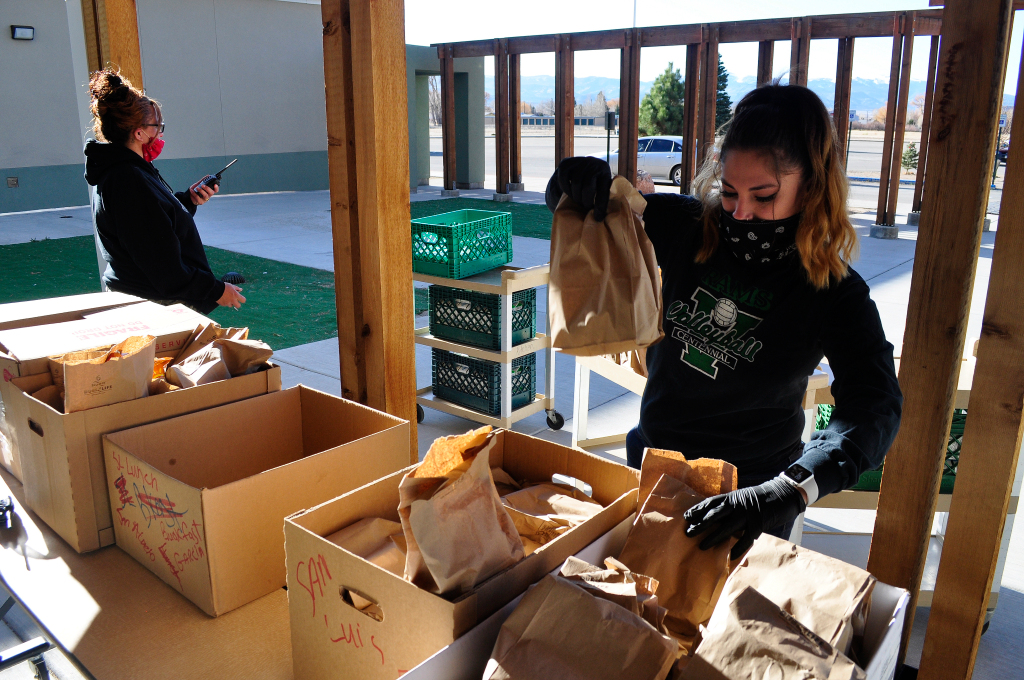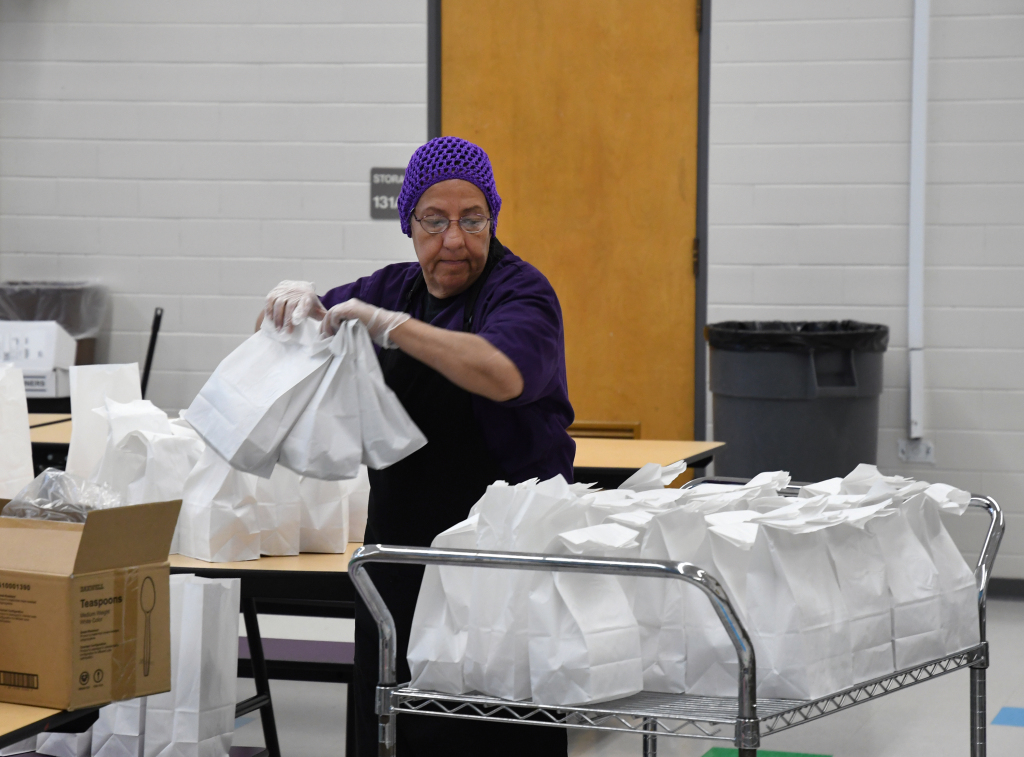
In Colorado Springs, gym teachers are shooting videos of their own kids making jump ropes out of plastic grocery bags.
All across the state, kids are growing weary of pancakes on a stick and calorie-packed Uncrustables PB&Js.
In Denver, high schoolers are wondering how to get their PE graduation requirements in a pandemic year when many qualifying team sports are canceled and schools drop gym classes in favor of fitting core curriculum into limited online windows.
In Las Animas, the nutrition director personally drove bagged meals to shut-in families in the spring. This fall, on Thursdays when the four-day district bags 1,600 meals to get families through Friday, everyone from the superintendent to the janitor slings sandwiches into sacks cramming the lunchroom tables.
The pandemic has undone a decade of carefully laid plans to improve school nutrition choices and get sedentary kids back up and moving, according to interviews with districts across Colorado. Frustrated cooks and gym teachers are making heroic efforts to overcome the obstacles of COVID-19, through anything from portable scratch baking to crowd-sourced PE videos produced by creative families.
Many districts, of course, are in remote-learning mode and only now considering how to get back to in-person learning. PE classes for elementary-age students are nonexistent or considered “specials” offered sporadically during live or recorded video sessions. Lunches — and often breakfasts for the next morning — are handed out from school parking lots in tens of thousands of “drive-bys” a day across Colorado.
Even for the districts or schools that are back in-person, there’s no return to normal for the PE and nutrition programs that make up the core of school-based health.
District 11 in central Colorado Springs warns exercising students to stay at least 3 feet apart, and gym teachers like Katie White are also tasked with recording movement videos for those who choose to stay home. Nutrition directors who had prided themselves on a decade of creating fresh salad bars, scratch soups and organic baking have to swallow hard and toss Uncrustables and plastic-wrapped apples into a sea of paper bags headed for classroom eating.

“Food directors are reaching out to us to brainstorm,” said Jessica Wright of LiveWell Colorado, a nonprofit that trains and advises schools and communities on healthier lifestyles. “And sometimes just cry for a bit about what’s changed.”
Keeping kids moving with 5-pound bags of sugar and scavenger hunts
Denver Public Schools, however, has tried to stay the course in serving students the kinds of meals they’re used to eating in school cafeterias, said Gosia Holthaus, the district’s manager of meal operations. DPS, like other districts, abides by nutrition guidelines from the United States Department of Agriculture. How those guidelines get met is where creativity and repetition do battle.
For DPS, it means lunches include some kind of grain, meat, fruit, vegetables and milk. One day, students might unwrap their lunch to find spaghetti with meat sauce, salad greens, an apple and plain or chocolate milk. Another day, they might dig into a cheese quesadilla with salsa, refried beans, sliced jalapeno peppers, fruit and milk. Two options are served each day, with a vegetarian choice always available.
Holthaus said nutrition is the district’s “No. 1 focus” as it develops menus for students. But her department also tries to ensure dishes look appetizing and works to provide a diverse menu to students so that they can look forward to their meal every day, she said.
DPS also creates its menus ahead of time, using nutrition analysis software to meet all its nutritional requirements. This school year, as the district has served meals that have proved to be popular in past years, it’s had to take into account the inventory stocked in its warehouse, Holthaus said. As important as nutrition is, DPS is also trying to make smart financial decisions and use up the inventory it has. Since many of the recipes it’s focusing on are from previous years, it is not purchasing any additional or any processed foods to fill its menu.
Packaging, though, has changed dramatically. Closed containers are now necessary, and students can no longer customize their meals as they could at some schools before the pandemic, Holthaus said.
In Centennial School District R-1, located in San Luis, kitchen staff now have a bit more flexibility in the foods they’re giving to students, and they must meet nutrition guidelines under Colorado’s Summer Food Service Program, said Crystal Quintana, food service director for the district. Those components — for lunch — include grains, meat or meat alternates, fruits or vegetables, and milk.
The southern Colorado district, which feeds a minimum of 200 kids during a typical school year, hasn’t struggled to get its pantry stocked, as some other schools have reported, Quintana said.
The rural district, which started fall classes remotely, has set up a system of drop-off points, where sack lunches are available to families every Monday and Wednesday. That will likely soon expand to Fridays, Saturdays and Sundays to fill a community need, Quintana said, though distribution of food has slowed down slightly. She’s trying to figure out why while also making nutritious meals more interesting with a better variety.
“We always want to get them the best nutrition,” she said. “That will never change.”

But as so much about the school day has changed amid COVID-19, districts like Centennial are facing more of a challenge in ensuring kids prioritize fitness and movement each day. K-12 PE teacher Roxann Serna tries to coach her students through Zoom, but she finds herself limited in how much she can get kids participating.
Using an academic program called Odysseyware, Serna gives students assignments that prompt them to take charge of their activities and be more independent. In one example, she tied different activities to different suits in a deck of cards, with a card’s number reflecting the number of reps a student had to complete.
In classes of elementary school students — Serna’s youngest students right now are third graders — she asks them to share with their peers their favorite activity at home and the exercise that made them feel more alert.
“They take ownership and pride in the activity that they’ve done for themselves,” she said.
Serna pushes older students to choose activities that will match their own fitness level and goals.
The teacher recognizes that some students don’t hold PE as a top priority among their other academic subjects, but she knows how important physical activity is to help students excel in their schoolwork.
“I don’t feel a lot of the kids are being physically active being at home, especially feeling bogged down with all the computer work that they have to do,” Serna said.

In Colorado Springs District 11, which is transitioning from remote to in-person learning, PE teachers tried to be mindful of vastly different family resources as they designed virtual programs.
“Some kids have a full weight set in the basement, other kids were having to use 5-pound bags of sugar,” said district PE director Chris Noll. Elementary and middle school students pitch in their ideas, which have ranged from carrying that 5-pound bag around the block, to painting “message rocks” and planting them around the school grounds. Kids who can walk safely to the school are encouraged to get outside, head to the school, and trade their painted rock for another.
Noll had his own family design and record crazy home obstacle courses — start seated in the car with seat belts on, yell “Go!,” run in the house, out the back door, around the yard, crawl under the dining room table, run upstairs, change shoes and lie down in bed with your clothes on until someone yells “Stop!”
One teacher, Noll said, was doing their own fundraising to make sure every family in the district at least had a new pink-rubber dodgeball at home, for throwing, kicking and catching.
Movement has remained top of mind for PE teachers in DPS, who are working to provide resources and models for students to keep moving at school or home, either through real-time instruction or on students’ own time, said Jessica Weber, a physical education instructional curriculum specialist for the district.
COVID-19 IN COLORADO
The latest from the coronavirus outbreak in Colorado:
- MAP: Known cases in Colorado.
- TESTING: Here’s where to find a community testing site. The state is now encouraging anyone with symptoms to get tested.
- STORY: PCR? Antigen? Antibody? Your guide to the different kinds of coronavirus tests and how accurate they are
As DPS has veered away from partner or group work, team sport based activities and team-building activities in PE, for the sake of safety, classes are heightening their attention to individual skillbuilding, Weber said. They’re also focused on peer analysis of skills, personal fitness levels and social-emotional wellness.
And PE teachers are finding ways to engage students from a distance with both technology and creativity. Some students are learning through interactive movement-based videos. Some are taking on project-based tasks, creating scavenger hunts in their neighborhood, which push them to use cognitive skills as they move. And others are selecting a physical activity and analyzing their personal heartrate zones and exertion level related to that activity, Weber said.
The district has not changed its high school graduation requirement for PE, Weber said. However, it’s not clear how some juniors and seniors who still need PE credits will fit them in. Most high schoolers in DPS are taking only three or four classes at a time under pandemic rules, instead of the usual seven or eight that allow for more PE time. DPS students can substitute team sports participation for the PE requirement, but most sports have been canceled or delayed.
Thousands of students turn to school for meals
Though serving less-than-ideal lunches and breakfasts has pained many nutrition directors, they are more concerned about simply replacing much-needed calories for the same numbers of people they were serving before the pandemic. School breakfast and lunch — and weekend food packs — are the main source of nutrition for many students from families with free or reduced-price lunch status.
During a regular school year, DPS readies thousands of meals for students each weekday. This fall, it is distributing meals at 85 pickup sites with curbside service and through six bus routes, along which it delivers meals to pockets of families who qualify for free and reduced-price lunch.
Since the USDA extended its summer meal program, Holthaus said, DPS is serving free meals to all children ages 0-18, regardless of whether they attend a DPS school.

The challenge has been in estimating the number of meals needed each day and ensuring the district has enough food for all students. Numbers from last year can help indicate the volume of meals needed, Holthaus noted, but those figures are not always reliable.
In a normal year, District 11 kitchens served about 22,000 people a day, nutrition director Kent Wehri said. This summer, with relaxed federal rules for distributing on-the-go food to all comers, the Colorado Springs district put out 3,000 to 5,000 meals a day. On Sept. 18, the district served 5,327 meals.
“It’s very concerning as we know that a large number of students rely on school meals for their daily nutritional intake. We are continuing to increase our outreach to the community, and trying to think of new ways to get our message out,” Wehri said.
